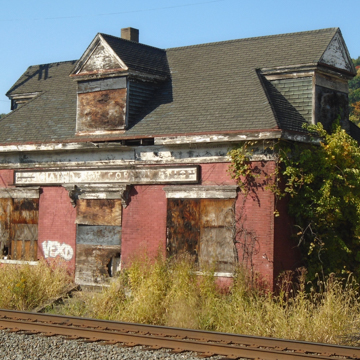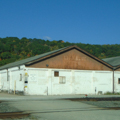You are here
Therm-o-Rock Buildings (Wightman Glass Factory Buildings)
Remnants of the Pittsburgh region's enormous glass industry are rapidly disappearing, which makes the three remaining Wightman Glass factory buildings in New Eagle, the small town north of Monongahela, a rare find. They lie between the former Pittsburgh, Virginia and Charleston Railroad (PVCRR) tracks and the Monongahela River. The largest brick building is an enormous gable-roofed structure with a gabled monitor at the ridgeline. Corbeling along the cornice of the monitor's gable end distinguishes a circular window vent, with three elongated rectangular windows below. A second brick, gable-roofed building has corbeling at the cornice line, gable ends, and chimney. The tiny office building looks like a train station, although lacking the characteristic deep overhanging eaves. Its hipped roof is broken by large double-windowed dormers. The first story has wide paired windows and a handsome central door with sidelights and transom facing the railroad tracks. Therm-o-Rock has been combining and packaging organic additives and mineral aggregates and powders here since 1948.
Writing Credits
If SAH Archipedia has been useful to you, please consider supporting it.
SAH Archipedia tells the story of the United States through its buildings, landscapes, and cities. This freely available resource empowers the public with authoritative knowledge that deepens their understanding and appreciation of the built environment. But the Society of Architectural Historians, which created SAH Archipedia with University of Virginia Press, needs your support to maintain the high-caliber research, writing, photography, cartography, editing, design, and programming that make SAH Archipedia a trusted online resource available to all who value the history of place, heritage tourism, and learning.




















